Automated Lead Generation
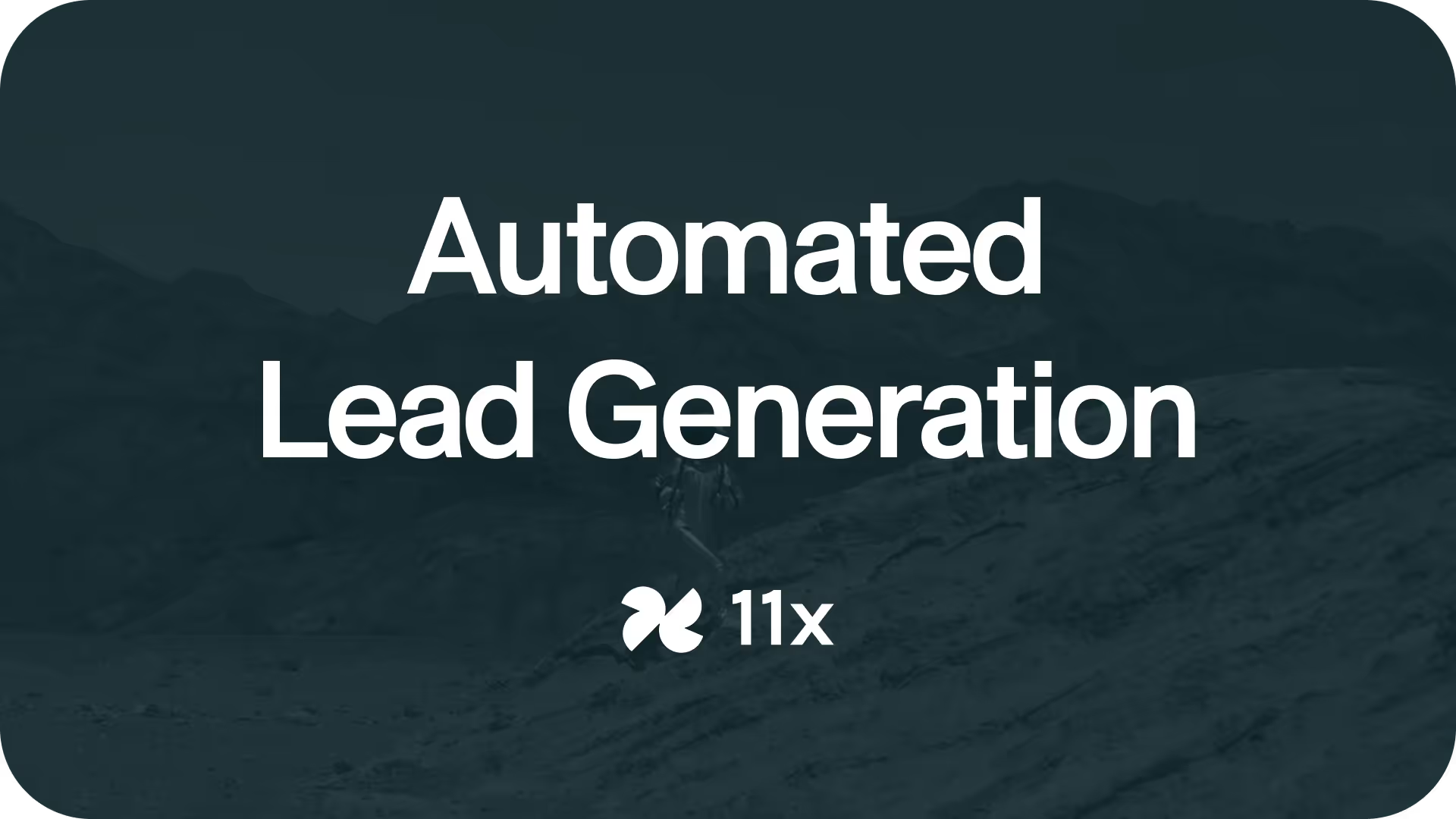
Manual prospecting once meant endless spreadsheets, cold emails, and follow-ups that never scaled. Today, automated lead generation replaces that grind with systems that identify, qualify, and engage buyers automatically through AI-powered lead generation software that connects data, outreach, and CRM workflows. These platforms merge data enrichment, outreach automation, and adaptive AI to create a continuous pipeline engine. The shift is not only about speed. It’s about precision, timing, and measurable conversion lift across every stage of the funnel.
11x operationalizes autonomous GTM execution through digital workers Alice and Julian, combining data intelligence and adaptive outreach in a single environment. Alice manages outbound prospecting by tracking market signals, researching leads, and engaging decision makers across channels, while Julian responds instantly to inbound interest, qualifying and routing prospects with precision. Together, they show how automation can function as an always-on growth layer that learns from engagement data, adjusts strategy in real time, and continuously sharpens the lead generation process without the overhead of coordinating multiple disconnected tools.
What Is Automated Lead Generation?
Automated lead generation orchestrates software, data, and AI systems that capture interest, score prospects, and trigger personalized outreach without human intervention. Common components include lead capture, enrichment, segmentation, lead nurturing, scoring, and customer relationship management (CRM) handoff. Automation improves conversion rates by acting on real-time signals instead of static contact lists. For effective B2B lead generation, these workflows combine chatbots, tracking pixels, and behavioral triggers to engage prospects faster.
Successful automation sends the right message to the right contact at the right moment. It eliminates manual tasks prone to human error while maintaining personalized, relevant communication that builds buyer trust. Modern systems track website visitors, monitor buying signals, and adapt messaging based on prospect behavior.
The most advanced platforms combine data intelligence, personalization algorithms, and execution speed within one environment. They identify perfect-fit prospects at scale, filtering millions of signals to surface ideal opportunities across every channel.
When integrated correctly, these lead generation tools streamline every stage of the lead generation process, turning web visitors into qualified opportunities.
How to Build Your Own Automated Lead Generation Infrastructure
Many GTM teams attempt to build their own automation stack from specialized point solutions. This modular approach offers flexibility and cost control but demands precise orchestration across multiple data layers and platforms.
Data & Prospecting Tools
Platforms like ZoomInfo, Apollo.io, and Clay provide verified contact databases and company intelligence. They help define your ICP and surface matching prospects.
However, data quality varies widely across providers, often requiring multiple subscriptions for full market coverage. Teams spend hours cleaning lists and validating contact information before campaigns even launch.
Enrichment & Verification Services
Solutions such as Clearbit, Hunter.io, and Dropcontact fill in gaps like direct phone numbers, social profiles, and technographic data.
Verification tools reduce bounces and protect sender reputation, but manual list maintenance becomes burdensome as lead volume grows. Because each provider covers different attributes, teams must stack multiple services to build complete, accurate profiles.
Outreach & Sequencing Platforms
Tools like Lemlist, Instantly, and Mailshake automate outreach across email, LinkedIn, and other channels. They offer A/B testing, deliverability tracking, and behavioral triggers, but maintaining hyper-personalization at scale remains difficult. Campaign setup also requires significant effort in designing sequences, templates, and logic flows.
CRM & Lead Management Systems
Systems such as HubSpot, Pipedrive, and Salesforce centralize prospect data and track engagement across the funnel.
When configured well, they unite scoring, campaign tracking, and meeting scheduling. But automation rules need constant monitoring, and sync workflows between tools often break, creating operational headaches that slow follow-up.
Automation Connectors & Tracking Tools
Solutions like Zapier, Segment, and Google Analytics connect the stack and measure performance. They enable powerful logic-based workflows but multiply complexity with every new connection. Each data handoff becomes a point of potential failure that can halt entire campaigns.
Trade-Offs of the DIY Stack
The do-it-yourself route provides granular control. Teams can fine-tune individual tools and swap vendors without redesigning the full system.
But managing synchronization, billing, and deliverability across fragmented systems drains time and technical capacity, especially for smaller teams.
Why 11x Simplifies It
11x consolidates every layer of the lead generation ecosystem into one adaptive loop. Instead of juggling six disconnected tools, revenue teams get integrated prospect discovery, enrichment, and outreach, all powered by real-time engagement data.
The result is a fully autonomous system that continuously learns, refines targeting, and turns signals into a pipeline without manual upkeep.
How to Choose the Right Lead Automation Platform
Selecting the right platform depends on your goals and infrastructure.
1. Automation Depth: Does it cover the full journey or only partial workflows?
2. Data Intelligence: Does it include enrichment and intent signals?
3. Ecosystem Compatibility: Can it integrate with your CRM and analytics stack?
4. Ease of Deployment: Are templates, analytics, and onboarding support available?
5. Scalability: Will it grow with your lead volume and complexity?
11x delivers a closed-loop automation system built for continuous learning and measurable pipeline lift, combining enrichment, outreach, and qualification in one environment.
The 10 Best Lead Generation Automation Tools in 2025
This section highlights the ten tools accelerating that transformation in 2025 and how each drives pipeline efficiency, where they fit within different GTM motions, and which teams benefit most from their adoption.
Below is a table that shows each tool and its features at a glance.
11x
- Core Focus: Autonomous AI outreach
- Strength: 24/7 multi-channel, continuous learning
- Weakness: Premium pricing
- Ideal For: Mid-market & enterprise B2B
HubSpot
- Core Focus: CRM + marketing automation
- Strength: Unified platform, easy workflows
- Weakness: Expensive at scale
- Ideal For: Growing businesses needing marketing-sales alignment
Apollo.io
- Core Focus: AI prospecting + database
- Strength: Huge B2B data, integrated tools
- Weakness: Data quality varies
- Ideal For: Outbound B2B teams on budget
Lemlist
- Core Focus: Personalized cold outreach
- Strength: Superior personalization, multi-channel
- Weakness: Needs external data
- Ideal For: Teams prioritizing personalized campaigns
Drift
- Core Focus: Real-time lead capture
- Strength: Instant visitor engagement
- Weakness: Web-traffic dependent
- Ideal For: B2B companies converting website visitors
ActiveCampaign
- Core Focus: Omnichannel nurture & automation
- Strength: Advanced automation, affordable
- Weakness: Complex for beginners
- Ideal For: SMBs/B2C brands seeking deep automation
Clearbit
- Core Focus: Lead enrichment & intelligence
- Strength: High-quality real-time data
- Weakness: Outreach requires other tools
- Ideal For: Enterprise ABM & segmentation
Clay
- Core Focus: Data enrichment & workflow orchestration
- Strength: Unified data, no-code flexibility
- Weakness: Steep learning curve
- Ideal For: Growth teams needing custom pipelines
PhantomBuster
- Core Focus: Web & LinkedIn data extraction
- Strength: LinkedIn & web automation
- Weakness: Compliance risks, limited enrichment
- Ideal For: Teams doing web/social prospecting
ZoomInfo
- Core Focus: Enterprise B2B intelligence
- Strength: Top-tier data & intent signals
- Weakness: Expensive & complex
- Ideal For: Enterprise sales teams doing large-scale lead gen
1. 11x: All-in-One AI Automation for Lead Generation and Outreach

11x applies autonomous intelligence to both outbound and inbound lead generation through Alice and Julian.
- Alice focuses on outbound execution by monitoring market signals, researching accounts, and engaging decision makers across email, LinkedIn, and phone channels. She identifies new opportunities and maintains targeted outreach at scale in over 100 languages.
- Julian manages inbound interactions, responding to new leads within seconds, qualifying them against defined criteria, and routing high‑potential prospects directly to sales. He also reactivates dormant records in the CRM and resumes conversations that show renewed buying intent.
Together, they demonstrate how automation can sustain a full‑funnel demand engine that learns and improves over time.
The platform combines intelligent buyer targeting with personalized, adaptive messaging that improves with every interaction. Unlike traditional tools requiring constant management, 11x operates 24/7 with proprietary mailbox management and deliverability infrastructure.
Alice and Julian learn from billions of data points to optimize campaigns continuously. They integrate seamlessly with your existing GTM stack while providing unified analytics across all channels. They handle complex multi-threading for enterprise accounts, personalized value propositions at scale, and automatic lead scoring based on real engagement patterns.
Pros: Fully autonomous execution, continuous learning AI, multi-channel orchestration, and proven pipeline acceleration.
Cons: Premium pricing compared to single-point solutions.
Best fit: Mid-market to enterprise B2B organizations seeking scalable outreach without tool bloat.
2. HubSpot Marketing Hub: CRM-Integrated Marketing Automation

HubSpot Marketing Hub coordinates campaigns, lead scoring, and nurture workflows within an intuitive interface for marketing-to-sales alignment. The platform leverages CRM data to power custom workflows, form automation, and AI-powered content creation. Its visual workflow editor enables complex multi-step journeys without technical expertise. Forms remember returning visitors and adapt based on behavior, shortening the path to conversion while maintaining data quality.
Built-in analytics track campaign performance across channels while predictive lead scoring prioritizes high-value opportunities automatically. The platform includes email marketing, social media management, SEO tools, and landing page builders in one integrated solution. Native Salesforce integration ensures seamless data flow between systems. Marketing teams can create targeted workflows for common scenarios like delivering content based on page visits or notifying sales reps when leads visit high-intent pages. The platform's AI capabilities extend to content generation, helping teams produce blog posts, social media captions, and email copy faster.
Pros: Comprehensive feature set, user-friendly interface, extensive app ecosystem with over 1,000 integrations. Its visual drag‑and‑drop editor helps create sophisticated lead nurturing sequences.
Cons: Can become expensive at scale with Professional plans at $890/month, learning curve for advanced features.
Best fit: Growing businesses seeking unified marketing and sales alignment with strong CRM integration needs.
3. Apollo.io: AI-Enriched Prospecting and Email Sequencing
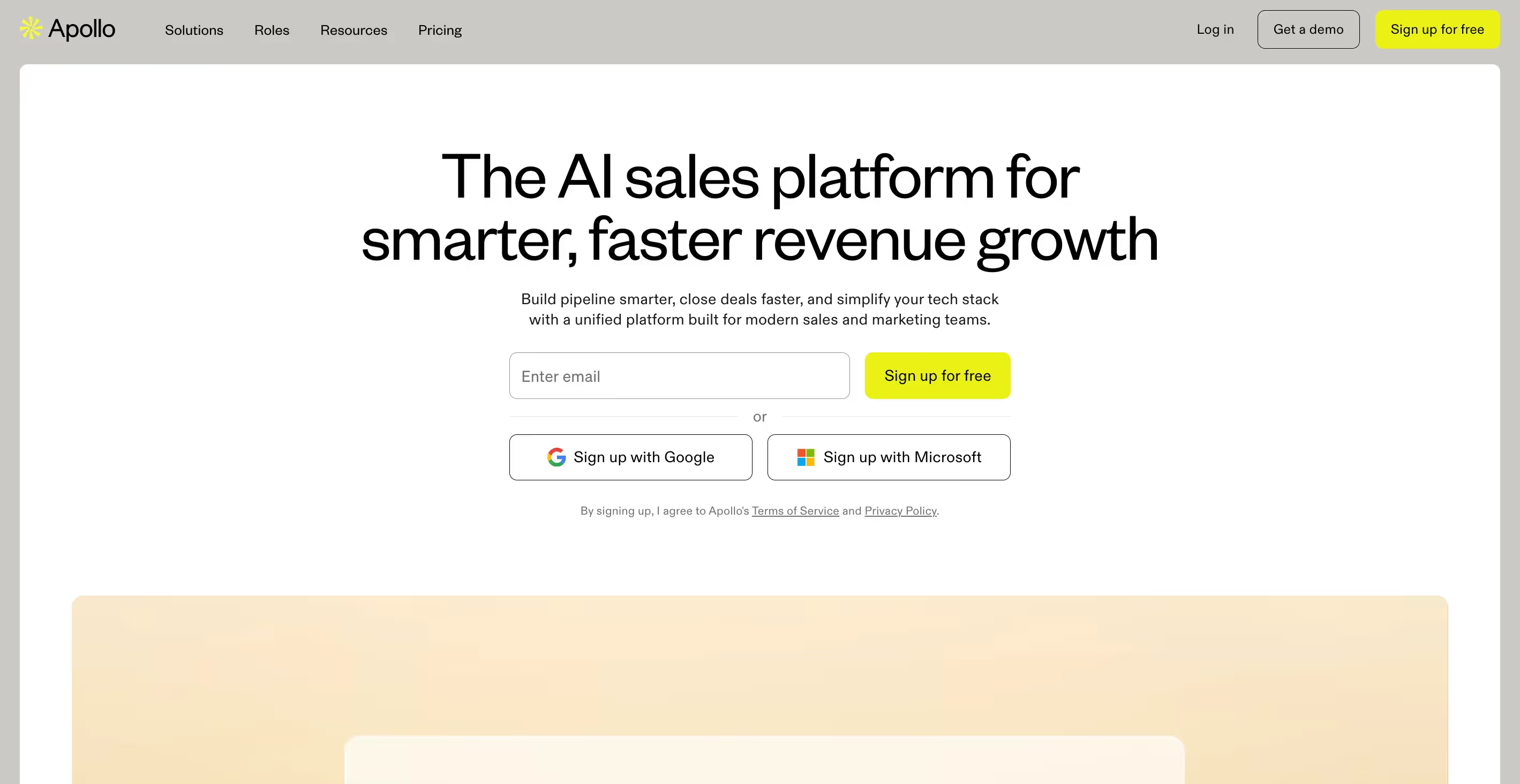
Apollo.io provides access to 210M+ contacts and 35M+ companies for large-scale B2B prospecting. The AI-powered platform combines data aggregation with automated outreach capabilities, reducing the need for multiple tools. Multiple data providers operate within one interface, delivering verified contact information, direct dials, and mobile numbers. The platform's AI assistant enables smarter outbound campaigns through personalization across every channel, from initial research to final follow-up.
Built-in call recording, meeting scheduling, and CRM synchronization streamline the entire sales cycle within one workspace. Automated scoring identifies high-intent prospects while maintaining data accuracy through continuous updates. Sales teams can run personalized outreach at scale without sacrificing quality. The platform tracks engagement across email, calls, and social touches, providing unified reporting on what drives conversions. Apollo's waterfall enrichment ensures maximum data coverage by checking multiple sources automatically.
Pros: Massive B2B database, integrated sales engagement tools, competitive pricing starting at accessible tiers.
Cons: Data quality varies by region and industry, limited automation compared to dedicated platforms.
Best fit: Outbound B2B teams prioritizing data coverage and integrated prospecting with budget constraints.
4. Lemlist: Personalization Engine for Cold Outreach at Scale
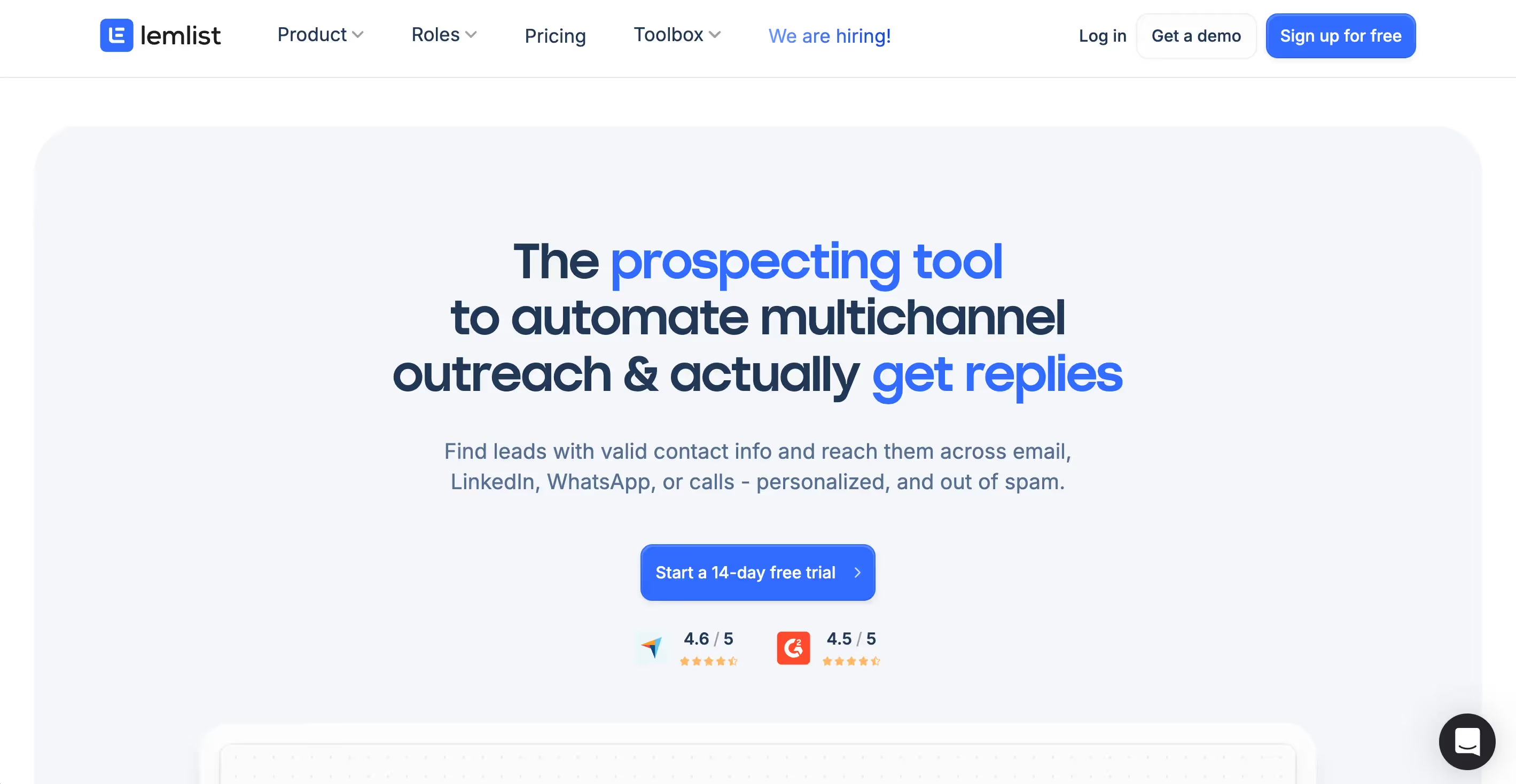
Lemlist automates personalized campaigns across email, LinkedIn, WhatsApp, and phone channels from one platform. The system emphasizes deliverability through built-in email warming (lemwarm) and reputation management features. Dynamic personalization capabilities enable image and video customization at scale without appearing templated. Teams can add personalized images, landing pages, and liquid syntax variables to create campaigns that feel individually crafted.
Advanced A/B testing optimizes send times, subject lines, and messaging variations automatically based on engagement data. The platform tracks performance across channels from one dashboard while maintaining human-like sending patterns to avoid spam filters. Native CRM integrations with HubSpot and Salesforce enable seamless data flow without manual imports. Smart sending algorithms ensure messages arrive when prospects are most likely to engage. The platform includes pre-built templates and proven sequences to accelerate campaign launch.
Pros: Superior personalization capabilities, multi-channel sequences, deliverability focus with free warm-up tool.
Cons: Limited lead data compared to full-stack solutions, requires external data sources for prospecting.
Best fit: Sales teams prioritizing personalized outreach over automated lead discovery, especially for cold email campaigns.
5. Drift: Conversational Automation for Instant Lead Capture
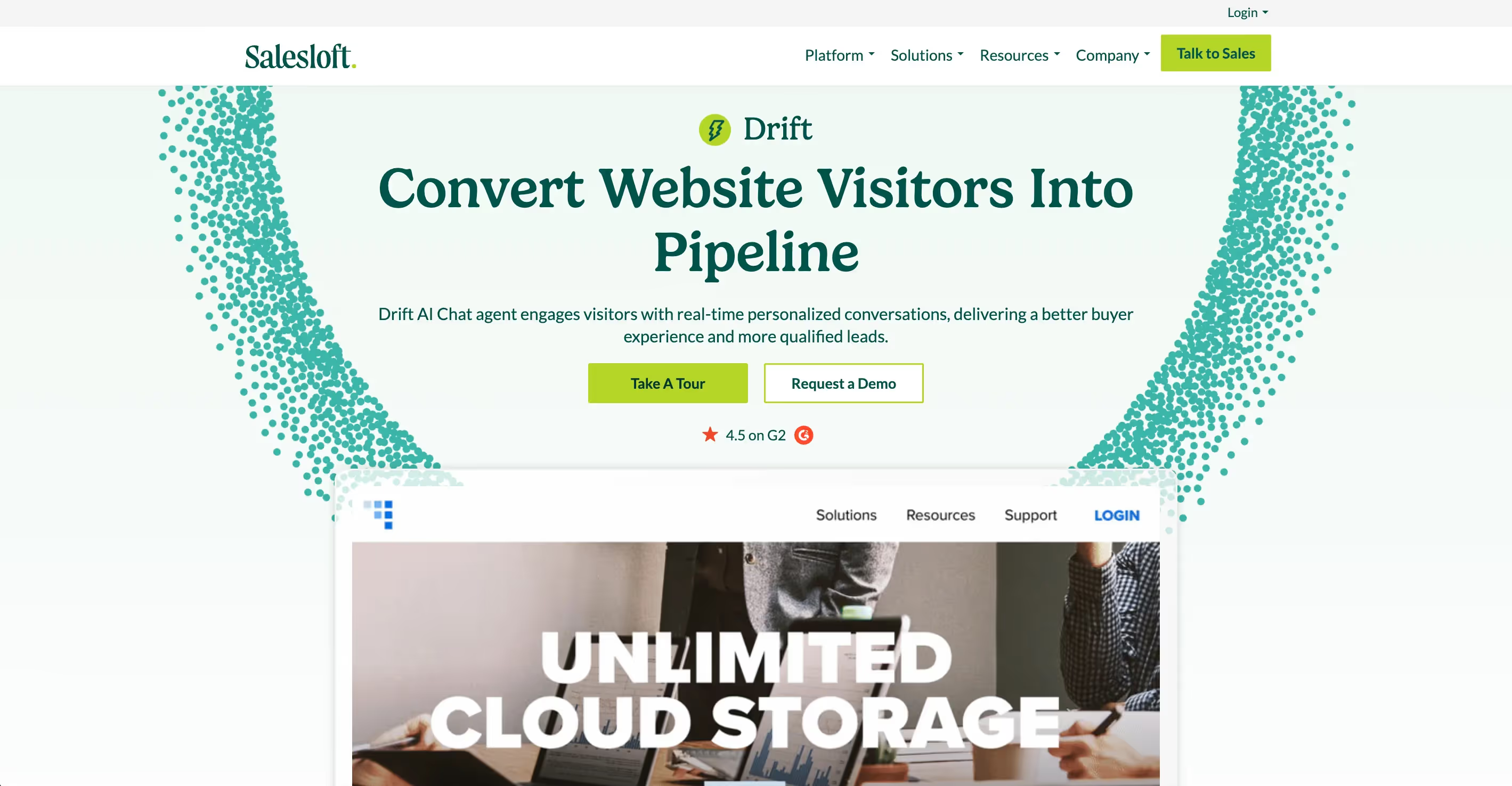
Drift uses AI chat agents to engage website visitors in real-time conversations that convert browsers into buyers. The platform identifies high-intent visitors through deanonymization technology, revealing company information, location, account history, and engagement scores instantly. Its conversational interface replaces traditional forms or pop-ups, delivering smoother, real‑time interactions that reduce drop‑offs and increase conversions. Qualified leads route directly into sales workflows through Rhythm integration for immediate follow-up. Fastlane technology enables high-value prospects to skip forms entirely, connecting with sales reps through instant chat or scheduled meetings.
The AI chat agent provides accurate answers to visitor questions 24/7, maintaining engagement when human reps aren't available. These chatbots qualify visitors, answer questions, and convert leads instantly. Personalized conversations adapt based on visitor behavior, account data, and past interactions. The platform tracks engagement metrics, conversion rates, and revenue attribution for continuous optimization. Integration with Salesloft creates unified buyer engagement across chat, email, and calls. Marketing teams gain visibility into which chat experiences drive pipeline, enabling data-driven improvements to conversion strategies.
Pros: Real-time visitor identification, instant lead qualification, seamless handoff to sales teams.
Cons: Limited to inbound lead capture, requires significant website traffic for ROI.
Best fit: B2B companies with established web presence seeking immediate visitor conversion and qualification.
6. ActiveCampaign: Omnichannel Nurture and Follow-Up Automation
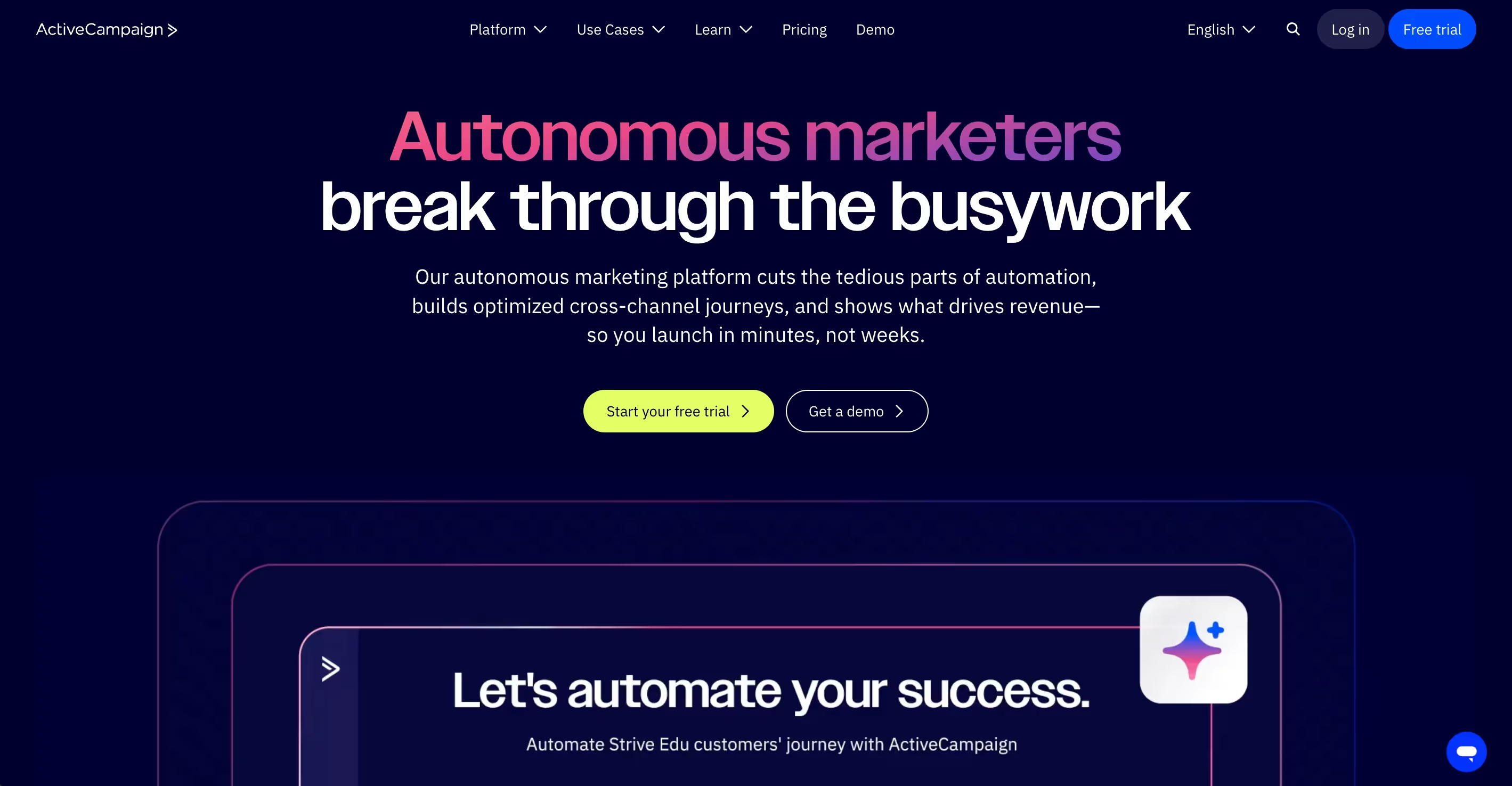
ActiveCampaign combines email marketing, CRM, and sales automation within an autonomous marketing platform powered by Active Intelligence. AI agents handle content creation, campaign optimization, and performance analysis automatically while maintaining brand consistency. The platform supports sophisticated triggers, split testing, and complex workflows for advanced users who need granular control. Behavioral segmentation enables precise targeting based on engagement patterns, purchase history, and customer lifecycle stage.
Cross-channel capabilities include SMS, WhatsApp, and social messaging automation that keeps brands connected across customer preferences. Over 1,000 app integrations connect the platform with existing marketing tools while maintaining unified reporting. The visual automation builder makes complex journeys simple to create and modify. Predictive sending optimizes delivery times for each contact individually. Free one-on-one coaching helps teams maximize platform value from day one. The platform handles everything from simple autoresponders to multi-step, conditional campaigns with dynamic content.
Pros: Advanced automation capabilities, affordable pricing starting at $15/month, extensive integration options.
Cons: Interface complexity for beginners, limited B2B data enrichment compared to specialized tools.
Best fit: SMBs seeking sophisticated automation without enterprise pricing, especially for B2C and e-commerce.
7. Clearbit: Real-Time Enrichment and Anonymous Visitor Intelligence
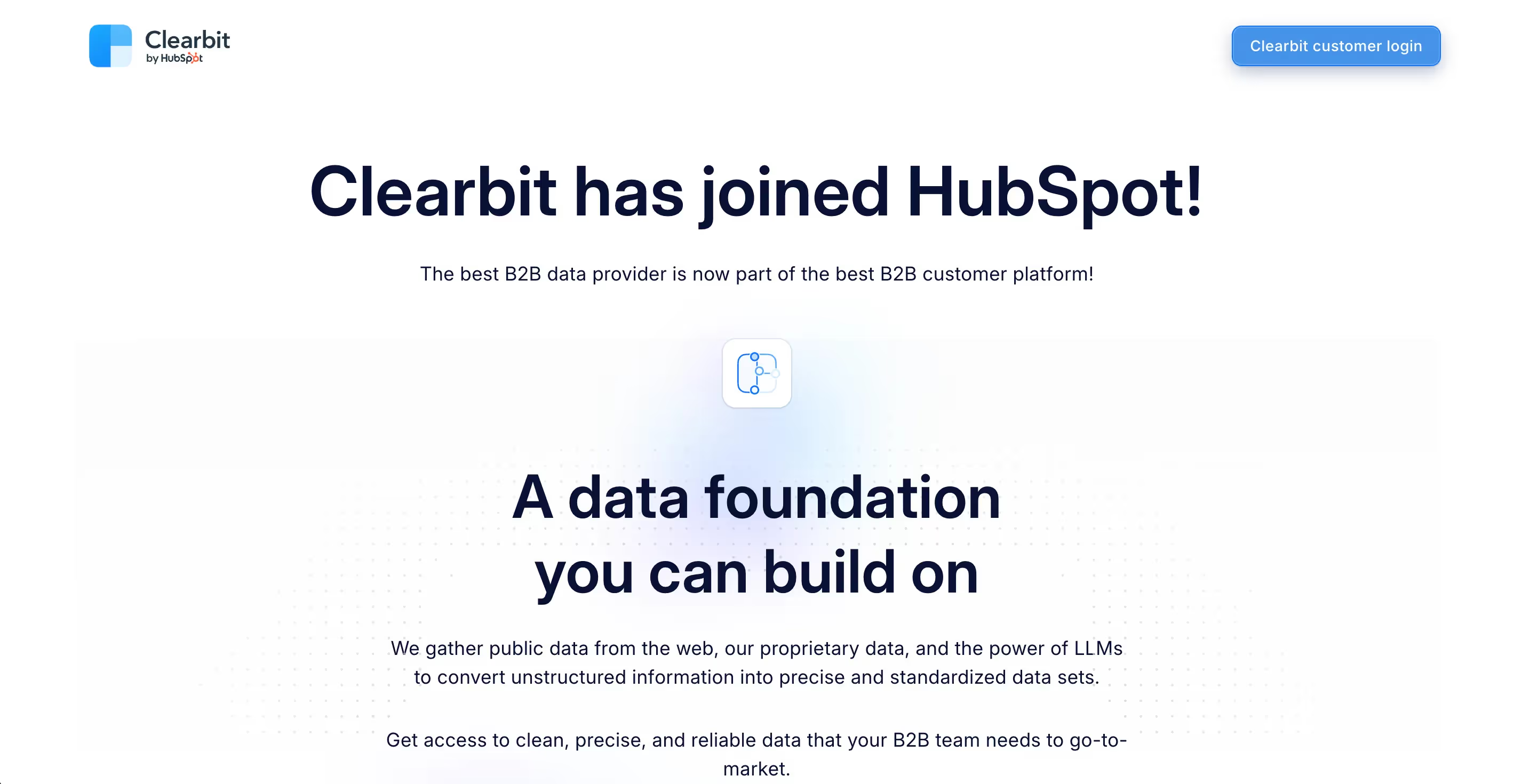
Clearbit identifies high-intent website visitors and enriches contact data across 250+ sources automatically. The platform appends 100+ B2B attributes including technologies installed, employee count, revenue data, and industry classification. Machine learning continuously improves data accuracy while detecting changes in real-time, ensuring your database stays current. Forms dynamically shorten based on available data, improving conversion rates without sacrificing information quality.
Powerful APIs and webhooks enable enrichment across any system, from CRM to marketing automation platforms. The platform powers precise lead scoring, routing, and segmentation based on enriched firmographic and technographic data. Sales teams receive complete context on every lead, including company size, growth trajectory, and technology stack. Marketing teams use enriched data to create hyper-targeted campaigns and personalized experiences. Real-time alerts notify teams when target accounts visit high-value pages. Integration with popular tools ensures enriched data flows seamlessly into existing workflows.
Pros: Industry-leading data quality, real-time updates, flexible API access for custom implementations.
Cons: Primarily enrichment-focused, requires separate outreach tools for complete automation.
Best fit: Enterprise teams prioritizing data accuracy for account-based strategies and personalization at scale.
8. Clay: Lead Enrichment and Workflow Orchestration with AI

Clay connects 100+ data providers through one subscription, eliminating multiple vendor contracts and simplifying data management. AI research agents automate manual prospecting tasks like summarizing job posts, enriching SMB data, tracking company news, and identifying buying signals. The platform enables conditional workflows without engineering resources, using simple logic to route leads, trigger enrichments, and update records based on any criteria.
Real-time intent signals trigger automated actions based on job changes, funding rounds, product launches, or competitive mentions. Built-in data cleaning ensures consistent formatting across sources while removing duplicates and standardizing fields. HTTP API capabilities enable custom integrations while maintaining security through SOC 2 Type II compliance. Teams can build complex enrichment waterfalls that check multiple sources until finding needed data. The platform learns from usage patterns to suggest optimal data sources and workflows. Clay's flexibility supports everything from simple list cleaning to sophisticated multi-step enrichment processes.
Pros: Unified data access, AI research automation, flexible workflow builder without code requirements.
Cons: Requires technical proficiency for advanced use cases, learning curve for workflow optimization.
Best fit: Growth teams seeking customizable data orchestration and enrichment with maximum flexibility.
9. PhantomBuster: Data Automation for LinkedIn and Web Prospecting
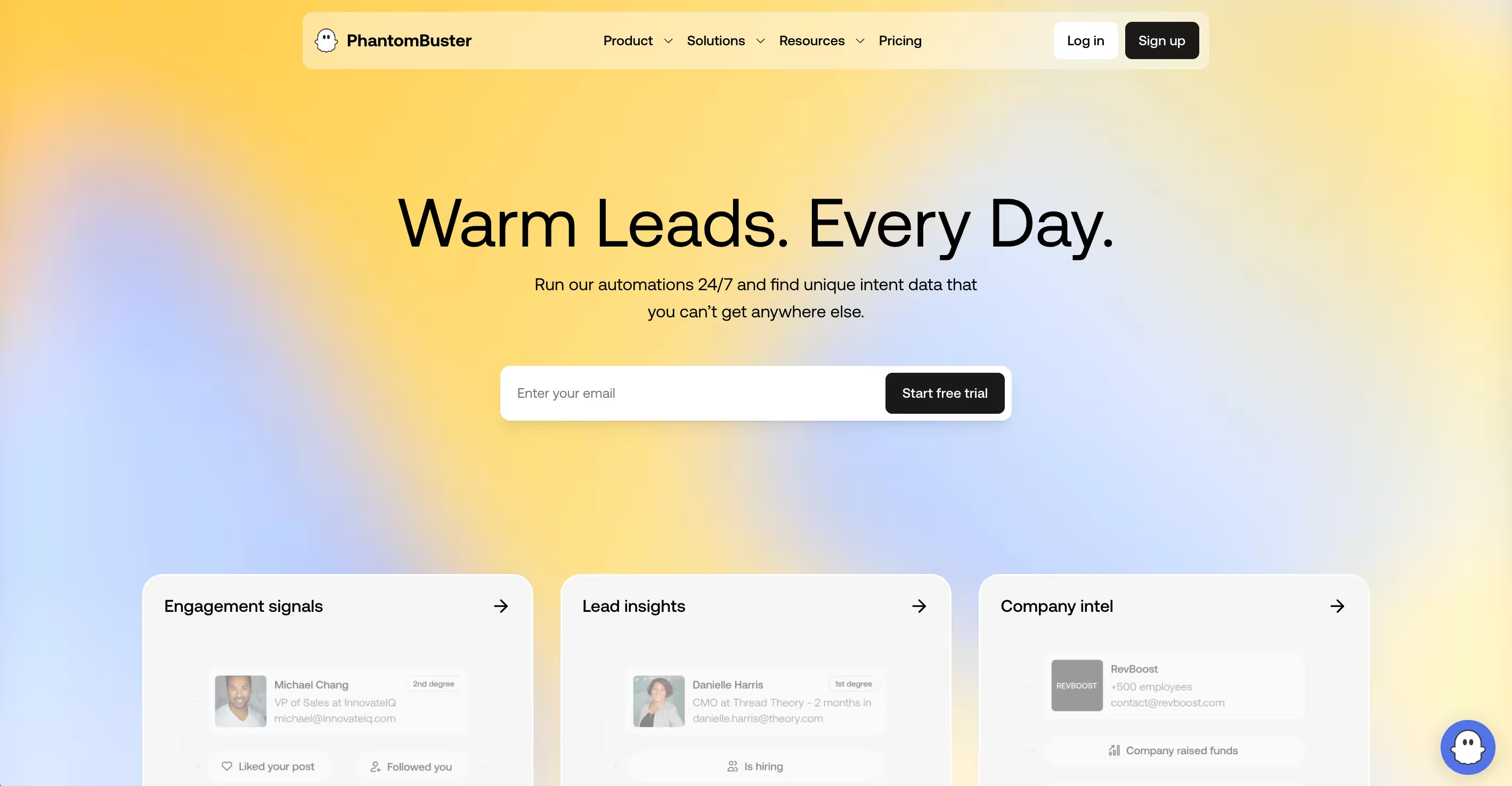
PhantomBuster scrapes, filters, and structures real-time lead data from public web sources at scale. The platform specializes in LinkedIn automation, extracting profile data, company information, post engagement, and connection networks. Cloud-based execution runs continuously without local infrastructure, processing thousands of profiles daily. Automated workflows feed extracted data directly into CRM systems or outreach platforms through API connections.
The platform handles complex extraction scenarios including dynamic content, infinite scroll, and authentication requirements. Pre-built automation templates cover common use cases like LinkedIn profile visits, connection requests, and message sequences. Custom scenarios enable extraction from any public web source with visual workflow builders. Data export options include CSV, JSON, and direct API delivery. The platform maintains multiple proxy networks to ensure reliable access and avoid rate limits. Teams can schedule extractions to run automatically, building fresh lead lists continuously.
Pros: LinkedIn specialization, cloud-based automation, custom scraping capabilities for any website.
Cons: Compliance concerns with platform terms of service, limited enrichment features beyond extraction.
Best fit: Teams requiring specific web data extraction for targeted outreach campaigns and social selling.
10. ZoomInfo: Enterprise B2B Data Intelligence Platform

ZoomInfo combines verified contact data with AI-driven intent scoring and buying signals for enterprise sales teams. The platform maintains accuracy through continuous verification across millions of data points, human researchers, and machine learning. Advanced filtering identifies in-market accounts based on technographic data, firmographic attributes, and real-time intent signals. Scoops provide insights on executive changes, funding events, and strategic initiatives before they become public knowledge.
Workflow automation triggers actions based on account activity, competitor mentions, technology adoption, or custom signals. Native integrations with major CRM and marketing automation platforms ensure data flows seamlessly without manual imports. Compliance features support GDPR and CCPA requirements through automated opt-out management and consent tracking. The platform's FormComplete technology converts anonymous visitors into known leads by progressively capturing information. Sales teams access mobile apps for on-the-go prospecting and account research. Advanced analytics track data usage, team performance, and ROI across the organization.
Pros: Enterprise-grade data coverage, advanced intent signals, comprehensive compliance features.
Cons: Premium pricing often requires annual contracts, and complexity requires dedicated administration.
Best fit: Enterprise sales teams requiring comprehensive B2B intelligence and compliance for global operations, particularly valuable for teams executing large-scale lead generation strategies.
Potential Risks and Safeguards in Automated Lead Generation
While automation tools are redefining how teams generate pipelines, the same systems can introduce new challenges when not properly managed. Automation can create risks if left unchecked, from unreliable lead generation software to misaligned marketing strategy execution. Generic messaging, inaccurate enrichment, or compliance lapses can damage brand reputation and weaken trust with buyers.
- Quality Control: Without review, tone drift or off-brand personalization can occur.
- Compliance Risks: Improper data capture may breach GDPR or CCPA standards.
- Reputation Management: Poor deliverability or spam flags can harm domain health.
- Context Loss: Over-automation can remove the nuance that builds trust.
Effective mitigation starts with clearly defined approval checkpoints for new templates and campaigns. Teams can reinforce quality through consistent segmentation rules, scheduled content and data audits, and transparent opt‑out systems that maintain compliance and trust.
11x addresses these risks through adaptive AI guardrails, real-time compliance monitoring, and brand-calibrated outreach that keeps automation precise and human-aligned.
Maintaining strong customer support processes alongside automation ensures that when prospects convert, their experience transitions seamlessly into long-term engagement.
Turning Data Into Demand
Automation has evolved from operational convenience to the strategic engine of GTM performance. The most advanced systems merge data intelligence, personalization algorithms, and execution speed within one environment.
11x enables companies to identify and convert high-value buyers around the clock, replacing fragmented tool stacks with one platform that offers autonomous performance.
Start building your automated lead generation engine with 11x and let Alice and Julian identify, engage, and convert qualified leads while your team focuses on closing deals. By embedding AI into your lead generation process, automation not only accelerates growth but also ensures the consistent delivery of high-quality leads.
Frequently Asked Questions
Automated lead generation uses AI systems and connected workflows to identify, qualify, and engage potential customers without manual coordination. It replaces tasks like list building and follow‑up scheduling with intelligent processes that act on real‑time data. By combining prospect discovery, enrichment, and messaging in one loop, it helps teams deliver faster response times and maintain consistent engagement quality at scale.
Automation connects data capture, enrichment, and outreach so interactions trigger automatically based on prospect behavior or predefined rules. For example, when a lead downloads content or revisits a pricing page, the system can send a personalized sequence or notify a rep. Each action feeds back into the platform to refine targeting and timing for future campaigns, steadily improving efficiency and conversion rates over time.
When tuned properly, automation improves both the accuracy and consistency of lead scoring. It evaluates live intent signals, engagement history, and data enrichment in real time to decide when a prospect is ready for outreach. Instead of flooding teams with unvetted contacts, it narrows focus to the most relevant buyers and creates a reliable pipeline of qualified leads supported by transparent performance data.
The best results come from blending structured automation with brand‑specific tone and human oversight. Teams can use defined message libraries, style guides, and approval processes to ensure every automated message reads authentically. This balance preserves brand voice and personal relevance while allowing AI to manage timing, sequencing, and data‑driven optimization in the background.
Automation manages the execution layer, but human review remains essential for strategic alignment and continuous improvement. People refine the data inputs, approve new campaign logic, and monitor conversational tone for brand consistency. Maintaining periodic checkpoints ensures that automation serves as an extension of the team’s judgment rather than a replacement for it.


.png)
.png)
.png)
.png)
.png)
